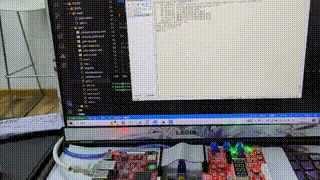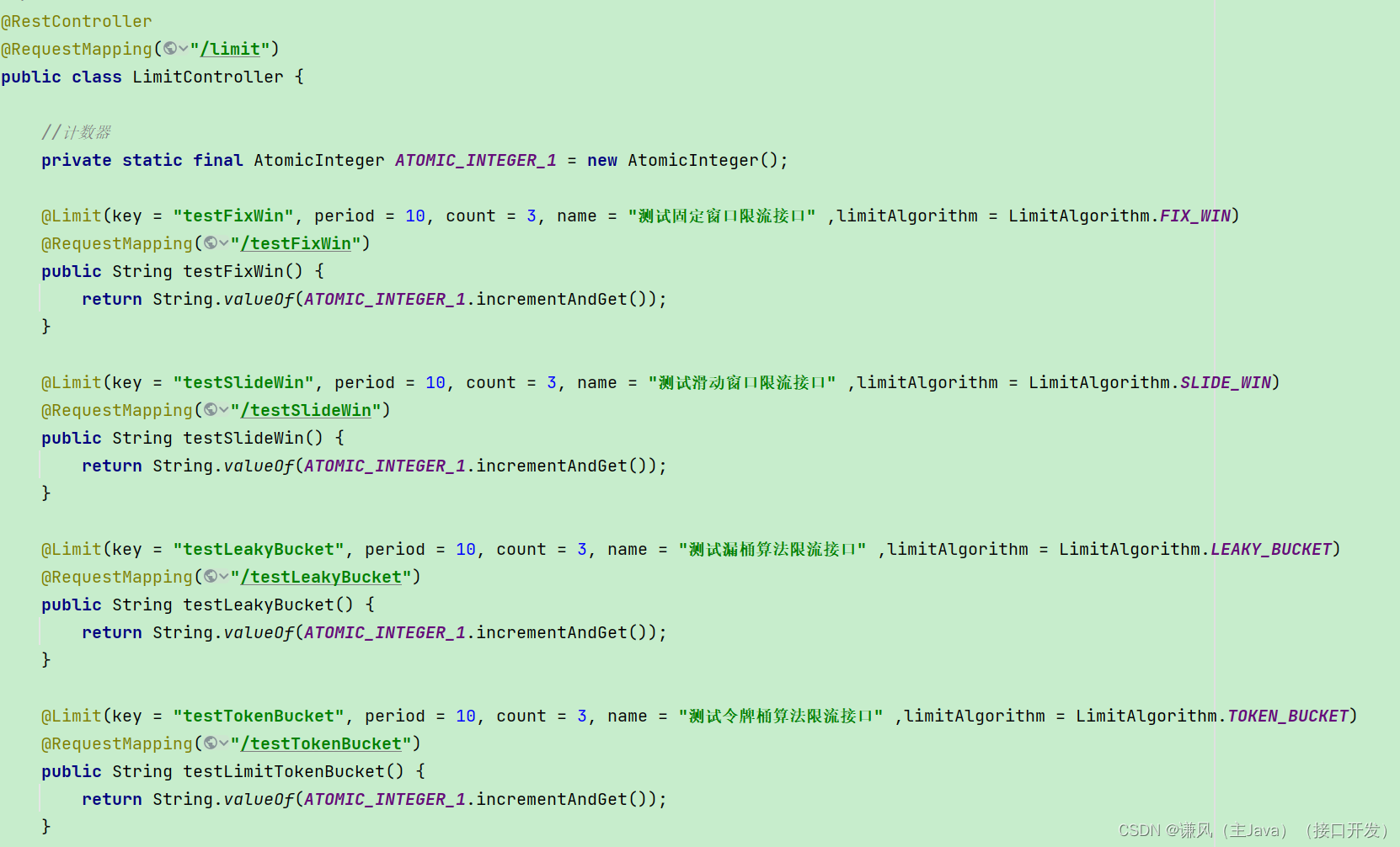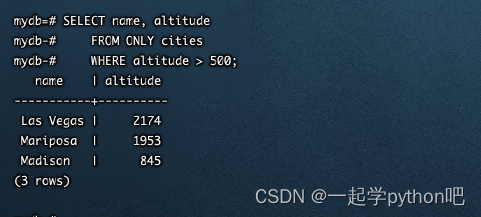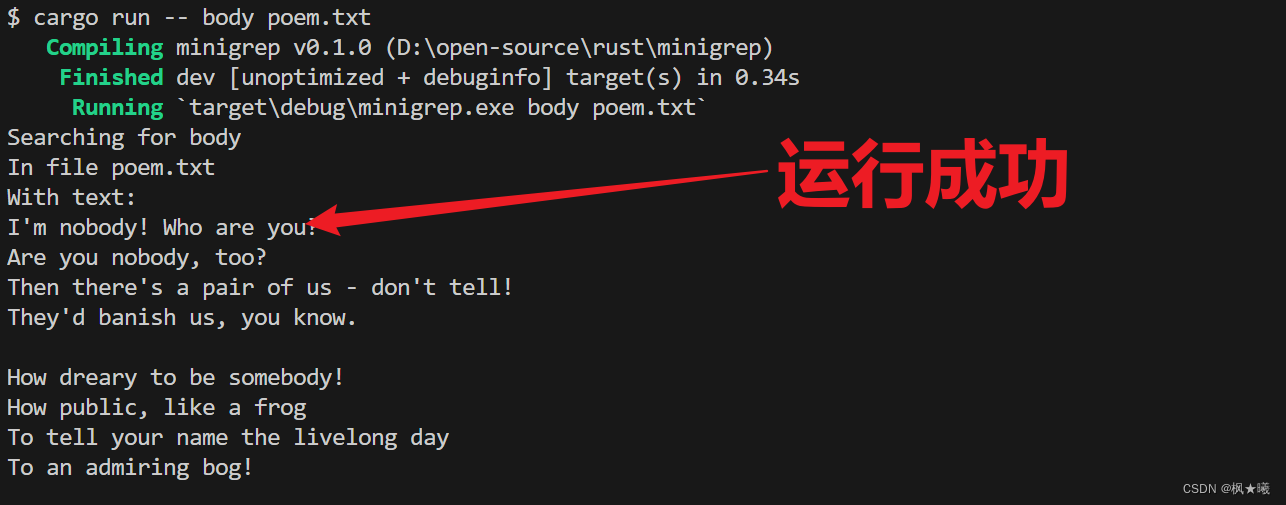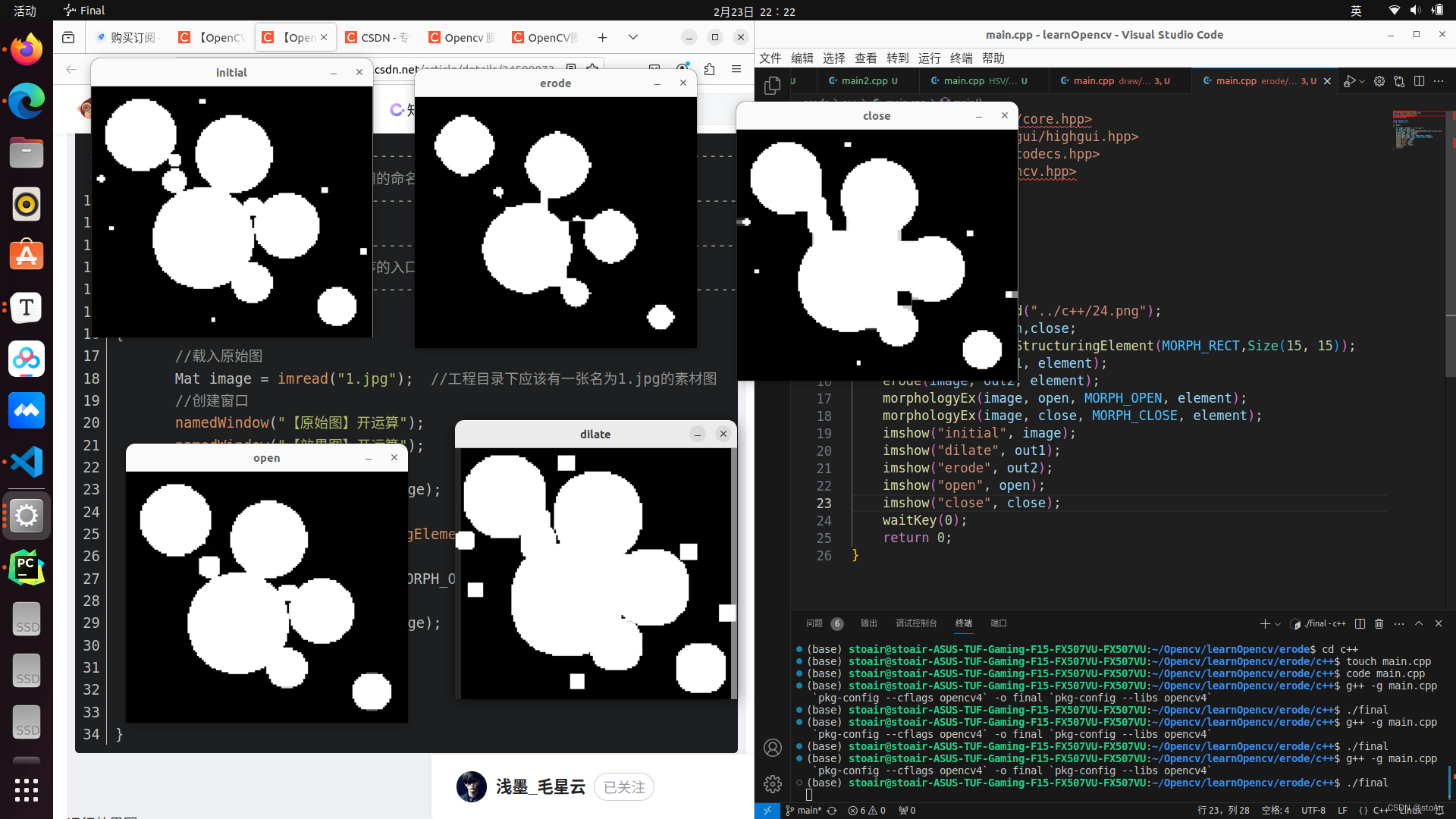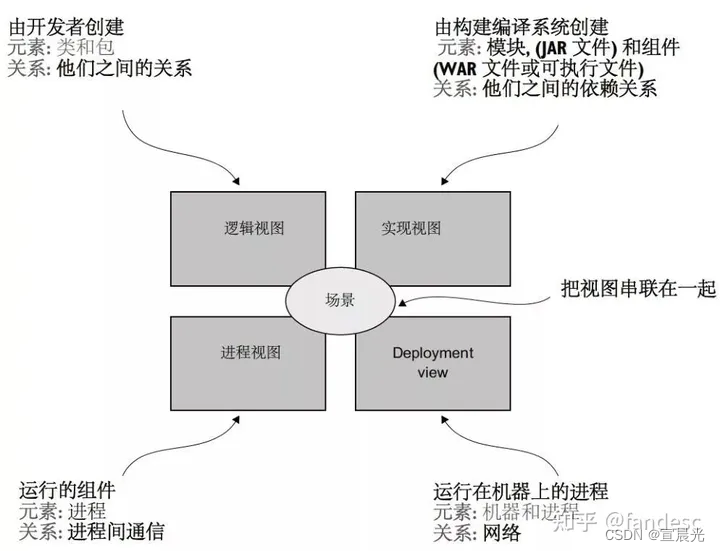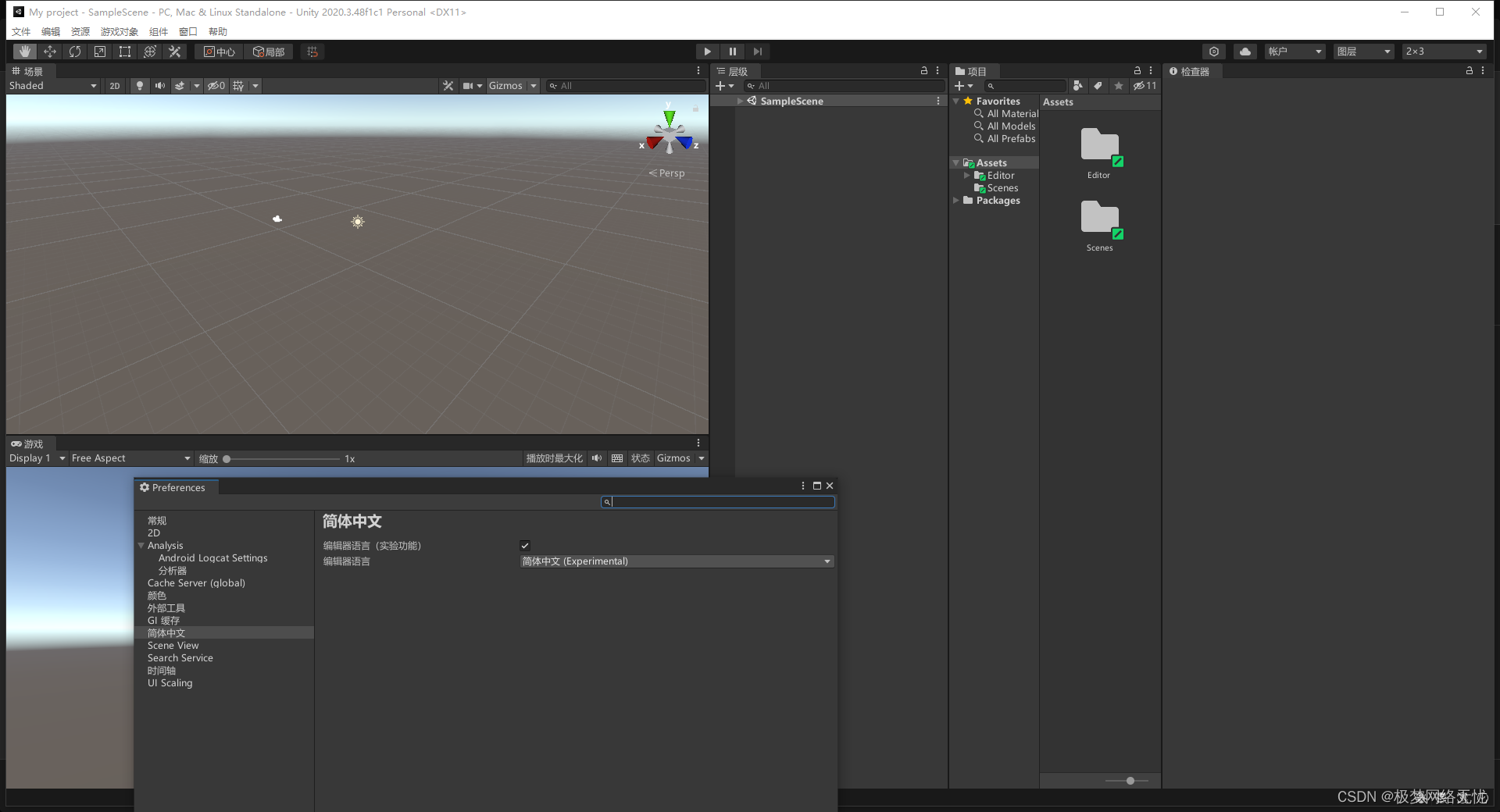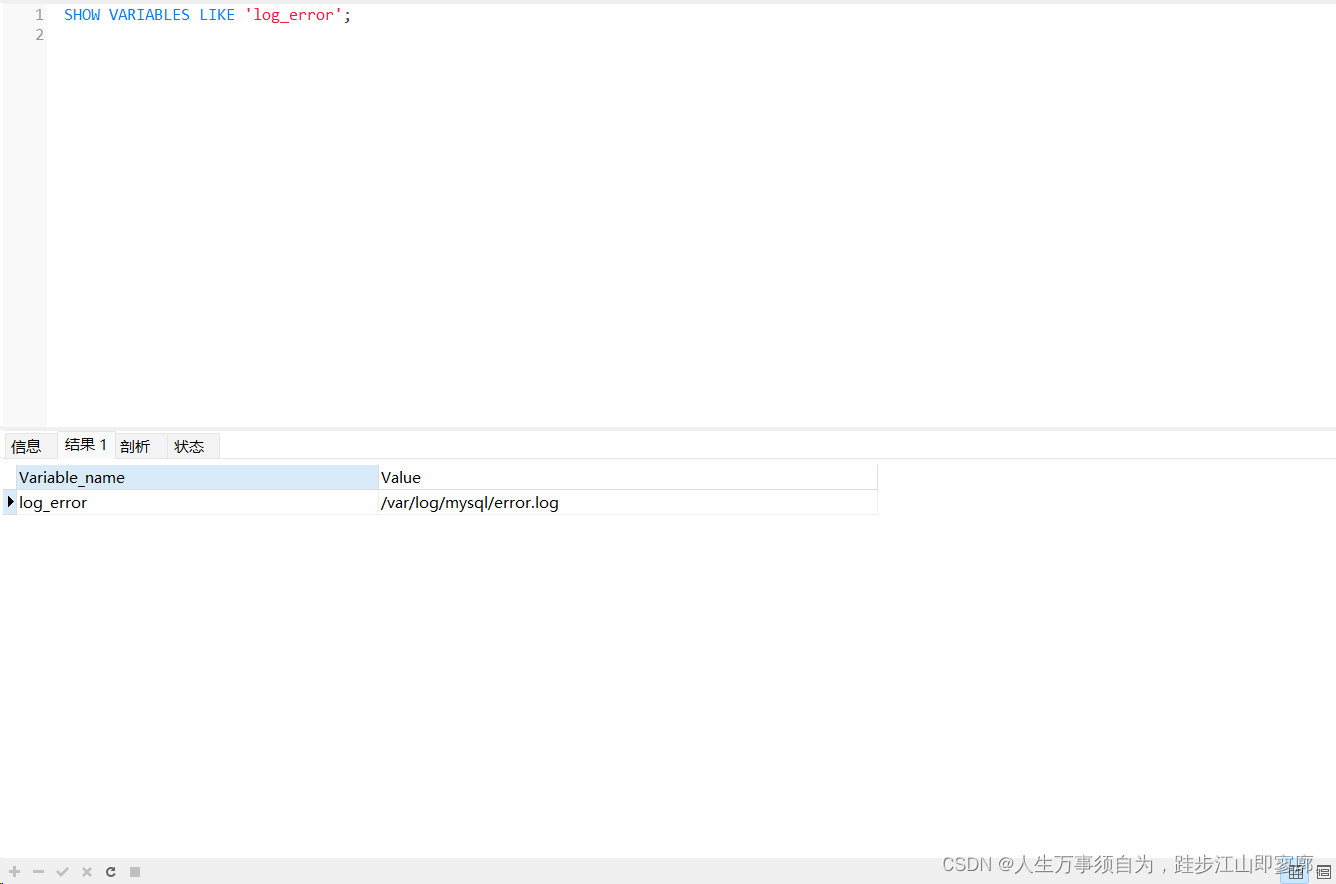目录
谷歌笔记本(可选)
决策树
决策树的一般流程
信息增益
划分数据集
递归构建决策树
使用Matplotlib注解绘制树形图
Matplotlib注解
构造注解树
测试和存储分类器
测试算法:使用决策树执行分类
使用算法:决策树的存储
谷歌笔记本(可选)
from google.colab import drive
drive.mount("/content/drive")output
Mounted at /content/drive
决策树
-
优点:计算复杂度不高,输出结果易于理解,对中间值的缺失不敏感,可以处理不相关特征数据
-
缺点:可能产生过度匹配的问题
-
适用数据类型:数值型和标称型
决策树的一般流程
(1)收集数据
(2)准备数据
(3)分析数据
(4)训练算法
(5)测试算法
(6)使用算法
信息增益
# 计算给定数据集的香农熵
from math import log
def calcShannonEnt(dataSet):
numEntries = len(dataSet)
labelCounts = {}
for featVec in dataSet:
currentLabel = featVec[-1]
if currentLabel not in labelCounts.keys():
labelCounts[currentLabel] = 0
labelCounts[currentLabel] += 1
shannonEnt = 0
for key in labelCounts:
prob = float(labelCounts[key]) / numEntries
shannonEnt -= prob * log(prob, 2)
return shannonEntdef createDataSet():
dataSet = [[1, 1, 'yes'],
[1, 1, 'yes'],
[1, 0, 'no'],
[0, 1, 'no'],
[0, 1, 'no']]
labels = ['no surfacing', 'flippers']
return dataSet, labels
myDat, labels = createDataSet()
myDat, labelsoutput
([[1, 1, 'yes'], [1, 1, 'yes'], [1, 0, 'no'], [0, 1, 'no'], [0, 1, 'no']], ['no surfacing', 'flippers'])
calcShannonEnt(myDat)output
0.9709505944546686
myDat[0][-1] = 'maybe'
myDatoutput
[[1, 1, 'maybe'], [1, 1, 'yes'], [1, 0, 'no'], [0, 1, 'no'], [0, 1, 'no']]
calcShannonEnt(myDat)output
1.3709505944546687
划分数据集
# 按照给定特征划分数据集
def splitDataSet(dataSet, axis, value):
retDataSet = []
for featVec in dataSet:
if featVec[axis] == value:
reducedFeatVec = featVec[:axis]
reducedFeatVec.extend(featVec[axis+1:])
retDataSet.append(reducedFeatVec)
return retDataSetmyDat, labels = createDataSet()
splitDataSet(myDat, 0, 1)output
[[1, 'yes'], [1, 'yes'], [0, 'no']]
myDat, labels = createDataSet()
calcShannonEnt(myDat)output
0.9709505944546686
# 选择最好的数据集划分方式
def chooseBestFeatureToSplit(dataSet):
numFeatures = len(dataSet[0]) - 1 # 2
baseEntropy = calcShannonEnt(dataSet) # 0.9709505944546686
bestInfoGain = 0
bestFeature = -1
for i in range(numFeatures):
featList = [example[i] for example in dataSet]
uniqueVals = set(featList)
newEntropy = 0
for value in uniqueVals:
subDataSet = splitDataSet(dataSet, i, value)
prob = len(subDataSet) / float(len(dataSet))
newEntropy += prob * calcShannonEnt(subDataSet)
infoGain = baseEntropy - newEntropy
if(infoGain > bestInfoGain):
bestInfoGain = infoGain
bestFeature = i
return bestFeaturechooseBestFeatureToSplit(myDat)output
0
递归构建决策树
import operator
def majorityCnt(classList):
classCount={}
for vote in classList:
if vote not in classCount.keys():
classCount[vote] = 0
classCount[vote] += 1
sortedClassCount = sorted(classCount.items(), key=operator.itemgetter(1), reverse=True)
return sortedClassCount[0][0]# 创建树的代码
def createTree(dataSet, labels):
classList = [example[-1] for example in dataSet]
if classList.count(classList[0]) == len(classList):
return classList[0]
if len(dataSet[0]) == 1:
return majorityCnt(classList)
bestFeat = chooseBestFeatureToSplit(dataSet)
bestFeatLabel = labels[bestFeat]
myTree = {bestFeatLabel:{}}
del(labels[bestFeat])
featValues = [example[bestFeat] for example in dataSet]
uniqueVals = set(featValues)
for value in uniqueVals:
subLabels = labels[:]
myTree[bestFeatLabel][value] = createTree(splitDataSet(dataSet, bestFeat, value), subLabels)
return myTreemyDat, labels = createDataSet()
myTree = createTree(myDat, labels)
myTreeoutput
{'no surfacing': {0: 'no', 1: {'flippers': {0: 'no', 1: 'yes'}}}}
使用Matplotlib注解绘制树形图
Matplotlib注解
# 使用文本注解绘制树节点
import matplotlib.pyplot as plt
import warnings
warnings.filterwarnings("ignore")
decisionNode = dict(boxstyle="sawtooth", fc="0.8")
leafNode = dict(boxstyle="round4", fc="0.8")
arrow_args = dict(arrowstyle="<-")
def plotNode(nodeTxt, centerPt, parentPt, nodeType):
createPlot.ax1.annotate(nodeTxt, xy=parentPt, xycoords='axes fraction',
xytext=centerPt, textcoords='axes fraction',
va='center', ha='center', bbox=nodeType, arrowprops=arrow_args)
def createPlot():
fig = plt.figure(1, facecolor='white')
fig.clf()
createPlot.ax1 = plt.subplot(111, frameon=False)
plotNode('leaf01', (0.5, 0.1), (0.1, 0.5), decisionNode)
plotNode('leaf02', (0.8, 0.1), (0.3, 0.8), leafNode)
plt.show()createPlot()output
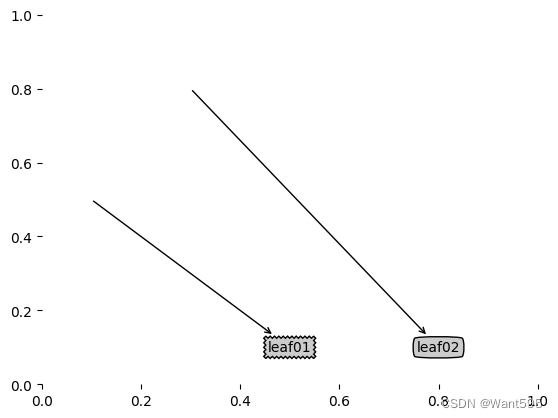
构造注解树
# 获取叶节点的数目
def getNumLeafs(myTree):
numLeafs = 0
firstStr = list(myTree.keys())[0]
secondDict = myTree[firstStr]
for key in secondDict.keys():
if type(secondDict[key]).__name__ == 'dict':
numLeafs += getNumLeafs(secondDict[key])
else:
numLeafs += 1
return numLeafs# 获取树的层数
def getTreeDepth(myTree):
maxDepth = 0
firstStr = list(myTree.keys())[0]
secondDict = myTree[firstStr]
for key in secondDict.keys():
if type(secondDict[key]).__name__=='dict':
thisDepth = 1 + getTreeDepth(secondDict[key])
else:
thisDepth = 1
if thisDepth > maxDepth:
maxDepth = thisDepth
return maxDepthdef retrieveTree(i):
listOfTrees = [{'no surfacing': {0:'no', 1:{'flippers':{0:'no',1:'yes'}}}},
{'no surfacing':{0:'no', 1:{'flippers':{0:{'head':{0:'no', 1:'yes'}}, 1:'no'}}}}]
return listOfTrees[i]retrieveTree(1)output
{'no surfacing': {0: 'no',
1: {'flippers': {0: {'head': {0: 'no', 1: 'yes'}}, 1: 'no'}}}}
myTree = retrieveTree(0)
getNumLeafs(myTree)output
3
getTreeDepth(myTree)output
2
def plotMidText(cntrPt, parentPt, txtString):
xMid = (parentPt[0]-cntrPt[0])/2.0 + cntrPt[0]
yMid = (parentPt[1]-cntrPt[1])/2.0 + cntrPt[1]
createPlot.ax1.text(xMid, yMid, txtString, va="center", ha="center", rotation=30)def plotTree(myTree, parentPt, nodeTxt):
numLeafs = getNumLeafs(myTree)
depth = getTreeDepth(myTree)
firstStr = list(myTree.keys())[0]
cntrPt = (plotTree.xOff + (1.0 + float(numLeafs))/2.0/plotTree.totalW, plotTree.yOff)
plotMidText(cntrPt, parentPt, nodeTxt)
plotNode(firstStr, cntrPt, parentPt, decisionNode)
secondDict = myTree[firstStr]
plotTree.yOff = plotTree.yOff - 1.0/plotTree.totalD
for key in secondDict.keys():
if type(secondDict[key]).__name__=='dict':
plotTree(secondDict[key],cntrPt,str(key))
else:
plotTree.xOff = plotTree.xOff + 1.0/plotTree.totalW
plotNode(secondDict[key], (plotTree.xOff, plotTree.yOff), cntrPt, leafNode)
plotMidText((plotTree.xOff, plotTree.yOff), cntrPt, str(key))
plotTree.yOff = plotTree.yOff + 1.0/plotTree.totalDdef createPlot(inTree):
fig = plt.figure(1, facecolor='white')
fig.clf()
axprops = dict(xticks=[], yticks=[])
createPlot.ax1 = plt.subplot(111, frameon=False, **axprops)
plotTree.totalW = float(getNumLeafs(inTree))
plotTree.totalD = float(getTreeDepth(inTree))
plotTree.xOff = -0.5/plotTree.totalW; plotTree.yOff = 1.0;
plotTree(inTree, (0.5,1.0), '')
plt.show()myTree = retrieveTree(0)
createPlot(myTree)output
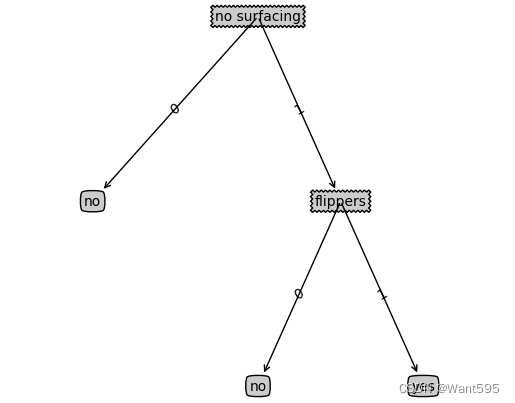
myTree['no surfacing'][2] = 'maybe'
myTreeoutput
{'no surfacing': {0: 'no', 1: {'flippers': {0: 'no', 1: 'yes'}}, 2: 'maybe'}}
createPlot(myTree)output
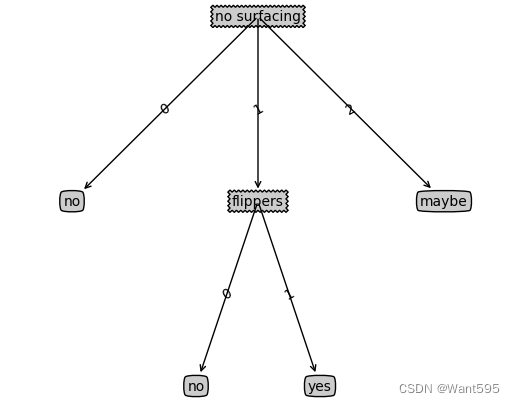
测试和存储分类器
测试算法:使用决策树执行分类
# 使用决策树的分类函数
def classify(inputTree, featLabels, testVec):
firstStr = list(inputTree.keys())[0]
secondDict = inputTree[firstStr]
featIndex = featLabels.index(firstStr)
for key in secondDict.keys():
if testVec[featIndex] == key:
if type(secondDict[key]).__name__ == 'dict':
classLabel = classify(secondDict[key], featLabels, testVec)
else:
classLabel = secondDict[key]
return classLabelmyDat, labels = createDataSet()
myTree = retrieveTree(0)
classify(myTree, labels, [1,0])output
'no'
classify(myTree, labels, [1,1])output
'yes'
使用算法:决策树的存储
# 使用pickle模块存储决策树
def storeTree(inputTree,filename):
import pickle
fw = open(filename,'wb')
pickle.dump(inputTree,fw)
fw.close()
def grabTree(filename):
import pickle
fr = open(filename, 'rb')
return pickle.load(fr)myTreeoutput
{'no surfacing': {0: 'no', 1: {'flippers': {0: 'no', 1: 'yes'}}}}
storeTree(myTree, 'classifierStorage.txt')
grabTree('classifierStorage.txt')output
{'no surfacing': {0: 'no', 1: {'flippers': {0: 'no', 1: 'yes'}}}}



